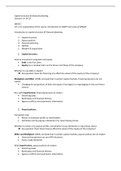Capital structure & financial planning.
Lectures: ch 14-22
WEEK1:
CH 1-13; organization of the course, introduction to CS&FP and recap of AP&CB:
Introduction to capital structure & Financial planning:
1. Capital structure.
2. Payout policies.
3. Financial planning.
4. Options.
5. Mergers & acquisitions
1. Capital structure:
Finance investment using debt and equity.
• Debt is the first claim.
• Equity has a residual claim on the future cash flows of the company.
Whether to use debt or equity?
➔ Key question: Does the financing mix affect the value (of the equity) of the company?
Modigliani and Miller (1958) conclude that in perfect capital markets, financing decisions do not
matter.
• Changing the proportions of debt and equity (=leverage) is a repackaging of risks and hence
returns.
But, with imperfections financing decision do matter:
• Distorting taxes.
• Bankruptcy and financial distress.
• Agency conflicts and asymmetric information.
2. Payout policies:
Companies may:
• Retain or distribute profits to shareholders.
• Distribute cash by paying a dividend or by repurchasing shares.
Whether to retain or to payout profits, and whether to pay dividends or repurchase shares.
➔ Key question: Does these choices affect the value (of the equity) of the company?
Miller and Modigliani (1961) conclude that in perfect capital markets, payout policies do not matter:
• Financial transactions are zero-NPV decisions.
• Home-made dividends.
With imperfections, payout policies do matter:
• Distorting taxes.
• Bankruptcy and financial distress.
• Agency conflicts and asymmetric information.
, 3. Financial planning:
Major decisions and external developments may reshape the future of the entire company.
Financial planning deals with these broader company challenges.
Key questions:
• Is value maximized?
• Is financing feasible?
➔ Proper answers are based on an integrated application of finance, accounting, business
analysis, best practices, and common sense.
4. Options:
Decisions? Use options:
• To magnify investment returns, or
• To hedge investment risks,
However, there are no free lunches.
- Derivatives: call and put options, forward contracts, futures, ....
- A call (put) option on a share is the right to buy (sell) the share at a prespecified price at or
before a specific date.
- The value of derivatives depend on today’s price of the underlying asset and the risk-free
asset only.
- Implications for modern capital structure theories: equity can be seen as a call option on the
assets of a company.
5. Merger and acquisitions.
Management questions:
• Acquire another company or not?
• Acquire at what price?
• How to finance the acquisition?
• Pay in cash or in shares?
On average the shareholders of the acquiring company obtain small or no gains whereas the
shareholders of the acquired company typically enjoy gains of 15% on the announcement of a
takeover,
Synergies (1+1>2) may explain why managers pay more than the fair market value of companies
,Recap of Asset pricing & Capital budgeting:
The valuation principle:
➔ In finance we always use market value. (Equity).
In competitive financial markets,
• Assets can be bought and sold at the same price.
• Equivalent (portfolios of) assets:
o Trade at the same price.
o Have the same expected rate of return.
• The value of an asset is the:
o Market price of an equivalent asset.
o Present value of the expected future cash flows using the expected rate of return of
an equivalent asset as discount rate.
Value depends on the expected size, timing and risk of future cash flows.
Discounting future cash flows:
- Perpetuity (forever)
- Annuity (period)
, Bond valuation:
- Face value
- Coupon rate
- Term to maturity
- Yield to maturity. (y)
• Discount bonds: Bonds that promise a single payment (face value) upon maturity.
• Coupon bonds: Bonds that promise multiple payments (coupon payments) before maturity
and one payment, the face value, at maturity.
• Zero coupon bonds: does not issue such interest payments.
• Corporate bond: With corporate bonds, the bond issuer may default—that is, it might not
pay back the full amount promised in the bond prospectus.
Coupon payment:
(𝑐𝑜𝑢𝑝𝑜𝑛 𝑟𝑎𝑡𝑒 ∗ 𝑓𝑎𝑐𝑒 𝑣𝑎𝑙𝑢𝑒)
𝐶𝑃𝑁 =
𝑛𝑢𝑚𝑏𝑒𝑟 𝑜𝑓 𝑐𝑜𝑢𝑝𝑜𝑛 𝑝𝑎𝑦𝑚𝑒𝑛𝑡𝑠 𝑝𝑒𝑟 𝑦𝑒𝑎𝑟
When cpn rate is equal to yield. Price of coupon is equal to face value.
Coupon rate > ytm. Price will be higher than face value.
Coupon rate < ytm. Price will be lower than face value.






